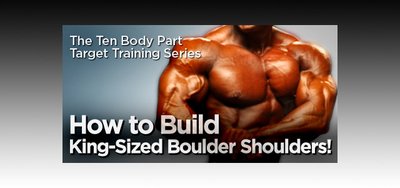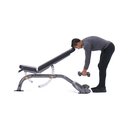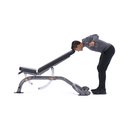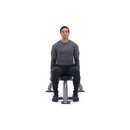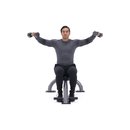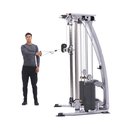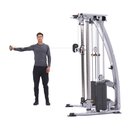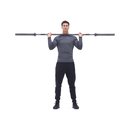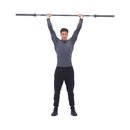We've all heard the sayings: a shoulder to rely on, shoulder the load, and sometimes it feels like you have the world on your shoulders. The shoulder region makes up a vital portion of our overall physique.
Viewed from the front, side and back, the deltoid and trapezius muscles are essential not only to a well-balanced look, but also facilitate many other functions which synergistically work to produce results in other areas. Strong, well-built delts and traps go a long way in regard to making the entire body look strong and balanced.
Shoulders make you look broad and strong. When we think of shoulders who comes to mind, Dennis Wolf, Marcus Ruhl, Jay Cutler, and Dennis James? When we think of these athletes we think of one thing: they are wide! Building proportionate delts and traps should be the goal of any trainer looking to build the ultimate physique.
One can often look at the shoulders as an integral piece of the infamous "X-frame" puzzle. If you were to draw diagonal lines from delt to calf, you would create the much sought after "X" physique.
With developed delts and traps, a conditioned midsection, and well-built calves, this dream can become reality. Toney Freeman is the go-to bodybuilder when is comes to X frames - and Toney is no slouch in the shoulders department.
The entire shoulder area is also essential in many, if not most bodybuilding poses. Viewed from any angle the front, middle, and rear delts must be equally developed in order to create the "complete look" along with nicely built traps.
Many trainers possess weak points such as underdeveloped posterior delts, overdeveloped anterior delts, and the lack of separation among all three heads. Do not fear; this article will provide you with the know-how to build some great boulder shoulders!
Quick Anatomy Lesson
With a muscle group as complex as the deltoid region it can get a bit confusing as to which deltoid head does what. With so many angles to choose from let's take a look at how they work.
Anterior Deltoid: Originating from the collar bone and attaching to the humerus, the anterior (front) deltoid head raises the arm away to the front of the body. This deltoid head is heavily utilized in many pressing movements.
Lateral Deltoid: Also originating from the collar bone and inserting into the humerus, the lateral (middle) deltoid head abducts the arm out to the side and away from the body. This head gives the upper body its wide look when developed properly.
Posterior Deltoid: Originating on the scapula and inserting on the humerus, the posterior (rear) deltoid head moves the arm away and back from the body. The posterior head is strongly utilized in back movements such as pulls and rows.
Trapezius: The trapezius muscle is quite different in its anatomy. This seemingly simple muscle group has multiple functions.
This is a long, trapezoid-shaped muscle that runs along the upper section of the spinal cord, originating at the base of the skull and attaching in the middle of the lower back. The traps function includes scapular elevation (shrugging up), scapular adduction (bringing the shoulder blades together) and scapular depression (pulling the shoulder blades down).
Boulder Shoulder Action!
Now that you know a little about anatomy and function, let's delve into what makes outstanding shoulders. The movements and routines presented are designed to get the most out of each trip to the gym. Remember to always use good form and not to use too much weight to compromise your safety.
Military (Barbell) And Dumbbell Shoulder Press
Mainly working the anterior and lateral heads the military press can't be beat. Take a slightly wider than shoulder width grip and start with the bar just under chin level and press up without locking your elbows. Return to the start position. This should be one fluid motion without a long pause at the top of the movement.
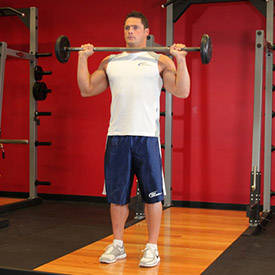
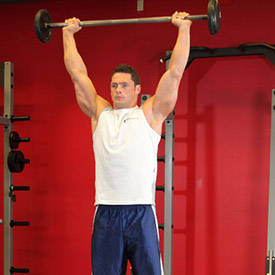
For dumbbell presses start with the dumbbells on either side of your head with your elbows flared to the sides. Make sure not to start the movement too high; start the dumbbells almost touching your shoulders. Press overhead simultaneously bringing the weights closer together at the top just short of locking your joints.
DO NOT clang the weights at the top of the movement—this will cause a shock to the shoulder joints. Return to the start and repeat.
Quick hit: A great alternative, and one in which requires less stability on your part, is the Smith machine press. This machine allows for a greater amount of weight to be used due to the reduction of ancillary muscles required. Also, it allows for ease of racking and un-racking the weight.
Dumbbell And Cable Side Lateral Raises
To target the lateral head of the deltoid complex side laterals do the trick. When performing dumbbell side lateral raises (seated or standing) start with the dumbbells slightly in front of your thighs with a slight bend in your elbows.
Here's the tricky part: you will not perform these as every other trainer has taught in the past (the ole "pour the pitcher of water" technique). You will bring the dumbbells out with the pinky in the up position the entire time.
This is a Charles Glass style lateral raise. The thumb will be pointing down the entire time with no twisting. This isolates the lateral deltoid head to an extreme extent so use light enough weight to perform it properly. Return the weight the same way and repeat.
For cable side laterals stand next to the cable apparatus and grip a "D" handle with your distant hand (the one away from the cable machine). Start with the handle in front of you so your arm crosses your body with a slight bend at the elbow and raise the weight up and out until you are parallel to the floor. Pause and squeeze at the top and lower the weight slowly in the same manner. Performing for each side counts as one set.
Quick hit: A good change of pace would be to perform leaning 1-arm laterals. Grip a dumbbell in one hand and grab a fixed upright in another. With your feet against the upright lean out to your side until your non-working arm is straight. Now the dumbbell is hanging at an angle from your body. Raise the dumbbell as you would the 2-arm version until your arm is parallel to the floor.
You will notice that you actually are a little higher than shoulder level as with normal laterals. This will activate more deltoid fibers and isolate one side at a time enabling you to use slightly more weight.
Bent Dumbbell Lateral Raises
For the posterior heads bent dumbbell lateral raises can be performed standing or seated. Be sure when performing these to bend over at the hips parallel to the floor as you would a Romanian deadlift and not the waist.
Grip two dumbbells of moderate weight and begin the movement with a slight bend at the elbow and raise the weight up and out to the sides. Come parallel to the floor and return to the starting position without clanging the weight together. Try not to raise the weight up and back too much; this will transfer the load to the back muscles.
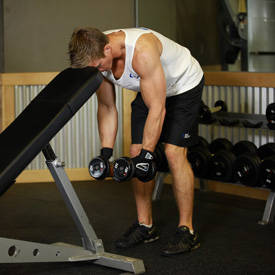
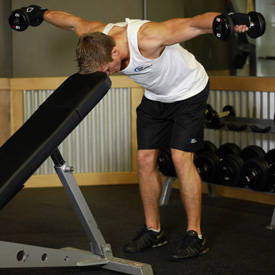
Bent-Over Dumbbell Rear Delt Raise
Quick hit: For a slight change and massive pump in the posterior delts try cable rear laterals. Stand in a cable crossover station and grip the cables (which should be set at shoulder level) with the opposite hands - grip the right cable with your left hand and the left cable with your right hand.
This position should have your arms crossed in front of you. Take one step back so your arms and the cables can clear your body. Uncross your arms with a slight bend at the elbow and pull the weight back as in the bent over version. Squeeze your deltoids and slowly return the weight.
Barbell And Cable Wide-Grip Upright Rows
To ultimately get that overall roundness to the deltoids, especially the lateral heads, wide-grip upright rows are the perfect choice.
Grasp a barbell with an overhand grip a few inches outside of shoulder width in front of your thighs. Pull the weight up along your upper body with elbows out until your upper arms are parallel to the floor. Squeeze the delts at the top and return to the start.
With cable upright rows simply attach a long bar to a low cable pulley and perform the same hand placement and movement as above. Utilizing the cables will give the muscle constant tension especially the squeeze at the top for a maximum contraction.
Quick hit: For those who have shoulder problems or find upright rows a bit uncomfortable and still want to reap the benefits of this movement, try some dumbbell upright rows. Hold the dumbbells in front of your thighs and pull the weight up as with barbell upright rows. The difference will be the freedom of arm movement which will alleviate some stress from the shoulder area.
Barbell And Dumbbell Front Raises
Used often as a great finishing movement for the anterior and lateral deltoid heads are front raises. Hold a barbell with an overhand grip about shoulder width in front of your thighs.
With a slight bend at the elbows raise the bar in front of you at the shoulder joint only until it is approximately eye level. Return the bar slowly to the start position.
For dumbbell front raises hold two dumbbells by your side with thumbs forward as if you were about to curl. Raise the weights out in front of you at the shoulder joint only without twisting. Once you have reached eye level return to start.
Quick hit: If your gym is busy and the weights are at times hard to get to or are being used another way to do front raises is with a weight plate. Plate raises are a convenient alternate to the barbell or dumbbells.
Grasp a weight that you can comfortably handle for your allotted reps as if you were holding a steering wheel. Make sure your grip is slightly on the underside of the plate so you can somewhat cradle it when you raise it. Raise and lower the plate as with dumbbell front raises.
Barbell And Dumbbell Shrugs
The granddaddy of trapezius movements is the barbell shrug. Grasp a barbell at shoulder width with an overhand grip against your thighs. Shrug up with your entire shoulder girdle reaching up to your ears and squeeze and slowly lower the weight back down.
Important note: DO NOT rotate the shoulder during this movement. It is simply an up and down movement. Do not circle the shoulders forward or back; this can cause injury.
Some trainers find dumbbell shrugs to be more comfortable and functional. Whereas a barbell is in front of you and can sometimes tip you forward, dumbbells are lifted from your sides and help with balance. Grasp a pair of dumbbells by your side as if you were going to curl and shrug them straight up and squeeze. Return the weight back to start and repeat.
Quick hit: If your flexibility calls for it, a variation of the barbell shrug could prove to be beneficial. The behind-the-back shrug is a great alternative to the traditional movements.
Stand grasping the bar with an overhand grip behind your hamstrings and glutes. Shrug the weight up as in a barbell shrug and squeeze. Your range of motion may be a bit limited, so be careful and maintain strict form.
Boulder Shoulder Schedules

BodyFit
$6.99/month- 2,500+ expert-created single workouts
- 3,500+ how-to exercise videos
- Detailed workout instruction
- Step-by-step workout tips
- Training at gym or at home
- Access to Workout Plans
- Access to Bodyfit App
- Store Discounts
Already have a Bodybuilding.com account with BodyFit? Sign In

What comes with BodyFit?

- Instructional Videos
Don't risk doing a workout improperly! Avoid injury and keep your form in check with in-depth instructional videos.

- How-to Images
View our enormous library of workout photos and see exactly how each exercise should be done before you give it a shot.

- Step-by-Step Instructions
Quickly read through our step-by-step directions to ensure you're doing each workout correctly the first time, every time.

BodyFit
$6.99/month- 2,500+ expert-created single workouts
- 3,500+ how-to exercise videos
- Detailed workout instruction
- Step-by-step workout tips
- Training at gym or at home
- Access to Workout Plans
- Access to Bodyfit App
- Store Discounts
Already have a Bodybuilding.com account with BodyFit? Sign In

What comes with BodyFit?

- Instructional Videos
Don't risk doing a workout improperly! Avoid injury and keep your form in check with in-depth instructional videos.

- How-to Images
View our enormous library of workout photos and see exactly how each exercise should be done before you give it a shot.

- Step-by-Step Instructions
Quickly read through our step-by-step directions to ensure you're doing each workout correctly the first time, every time.

BodyFit
$6.99/month- 2,500+ expert-created single workouts
- 3,500+ how-to exercise videos
- Detailed workout instruction
- Step-by-step workout tips
- Training at gym or at home
- Access to Workout Plans
- Access to Bodyfit App
- Store Discounts
Already have a Bodybuilding.com account with BodyFit? Sign In

What comes with BodyFit?

- Instructional Videos
Don't risk doing a workout improperly! Avoid injury and keep your form in check with in-depth instructional videos.

- How-to Images
View our enormous library of workout photos and see exactly how each exercise should be done before you give it a shot.

- Step-by-Step Instructions
Quickly read through our step-by-step directions to ensure you're doing each workout correctly the first time, every time.

BodyFit
$6.99/month- 2,500+ expert-created single workouts
- 3,500+ how-to exercise videos
- Detailed workout instruction
- Step-by-step workout tips
- Training at gym or at home
- Access to Workout Plans
- Access to Bodyfit App
- Store Discounts
Already have a Bodybuilding.com account with BodyFit? Sign In

What comes with BodyFit?

- Instructional Videos
Don't risk doing a workout improperly! Avoid injury and keep your form in check with in-depth instructional videos.

- How-to Images
View our enormous library of workout photos and see exactly how each exercise should be done before you give it a shot.

- Step-by-Step Instructions
Quickly read through our step-by-step directions to ensure you're doing each workout correctly the first time, every time.


